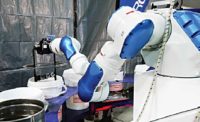In many automotive parts, a small defect can cause big problems. This explains why Tier 1 suppliers increasingly use machine vision to inspect parts used for steering, air bags, seat belts, brakes, electronic controls and exhaust.
Indianapolis-based Neff Group Distributors is an industrial automation company that provides custom systems for vision inspection. Recently, a Tier 1 supplier of exhaust system components asked Neff to build a system that verifies the proper assembly of butterfly valves. The supplier did not have a process in place to detect valve defects, and realized the need for such inspection when a customer reported that some parts were flawed upon delivery.
Neff designed a compact system because part inspection takes place in a space-constrained workstation. The system includes a Cognex In-Sight 7200 smart camera equipped with dual PatMax pattern detection, and two linear LM45 Mini-Lini lights made by Smart Vision Lights.
Each valve is inspected just prior to final welding and assembly to ensure that the valve’s rotating closure plate, or vane, is not misshapen, broken or otherwise damaged. A vane in this condition will not properly pivot, resulting in improper valve operation.
At the inspection station, the valve is manually placed into a fixture with the closure plate in the completely open position. Both the camera and LED lights sit just above the side of the valve body and directly face the pivot point. One linear light is placed on each side of the closure plate.
After the valve is fixtured, automatic triggers turn the lights on and activate the camera to take an image, which is bisected by the closure plate. The camera’s PatMax tools then compare the part pattern detected on each side of the image to what Neff engineers “taught” them is the pattern of an intact good part.
Parts that pass inspection are welded and sent on to the next operation. Defective parts are manually removed and placed into a contained area for future rework.
“The Mini-Lini lights proved to be the perfect size and brightness for the application,” says Kerry Whitt, field application engineer for Neff. “They are rugged enough for the metalworking environment in which they were installed. [And] being able to control them both with one output from the camera [simplified] the application.”
The lights feature four high-output LEDs and MultiDrive technology, which allows the lights to be operated continuously or in OverDrive Strobe mode, depending on wiring method. This technology also limits the duty cycle of the light and regulates the current delivered to the LEDs, thereby protecting them from premature degradation and failure due to excessive heat.
Available wavelength colors are 470-nanometer blue, 530-nanometer green, 625-nanometer red and 850-nanometer infrared. Multiple lensing options provide a broad spectrum of illumination and include 16, 25, 40 and 80 degrees. The five-pin M12 connector simplifies wiring, and the analog control regulates intensity (0 to 10 volts).
A companion series, the LM75, has eight LEDs and the same features. For more information on linear lights, call 231-722-1199 or visit https://smartvisionlights.com.







